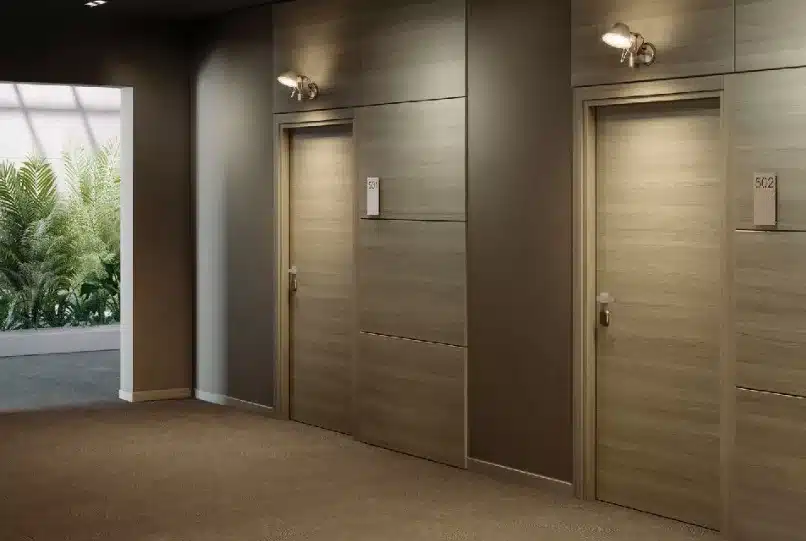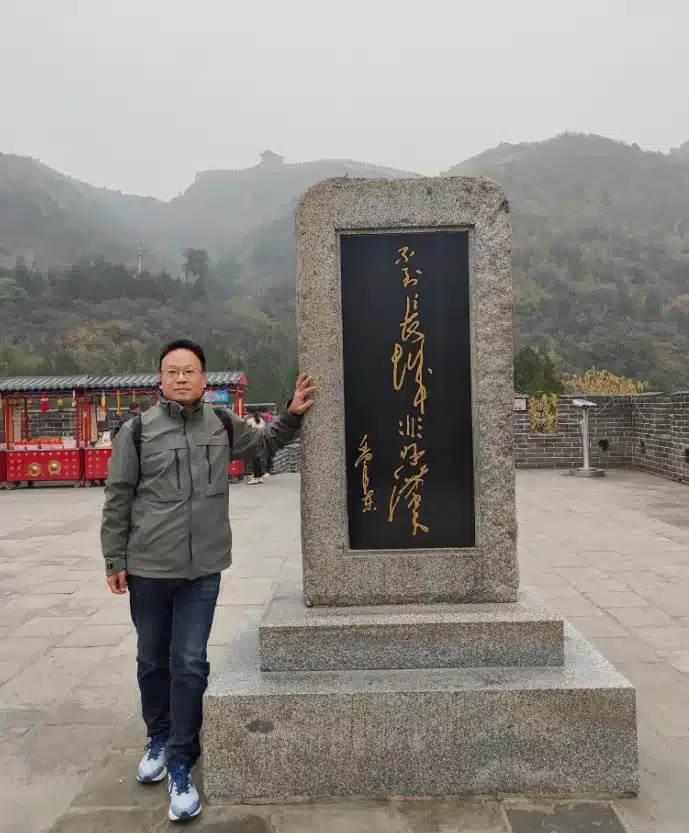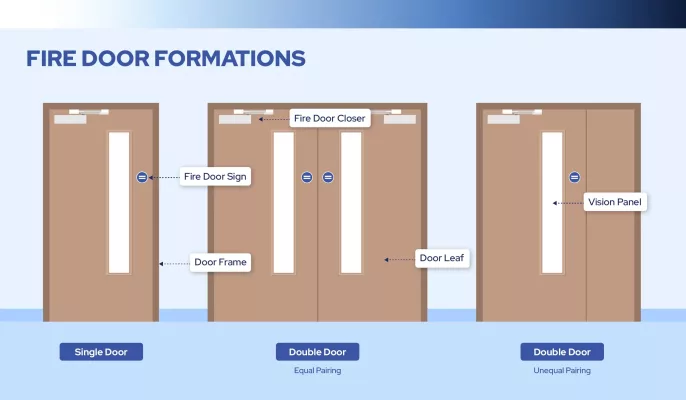In preparation for a new hospitality development in Saudi Arabia, the project’s procurement team conducted an extensive supplier review across China to secure UL 120-minute steel fire doors with STC-36 acoustic performance for guest room and corridor applications. After background checks and technical evaluations, the client selected Yuankai Door Industry’s Guangdong branch as the supply partner. On the day of their arrival, the Yuankai team arranged airport pickup at 11:00 AM and hosted the delegation at a well-known local hotel before an afternoon facility tour to review production, compliance documentation and fire-acoustic door structure in person.

Client Brief & On-Site Due Diligence (Buyer Journey)
From Desktop Research to Factory Gate
The Saudi project team didn’t begin with factory tours. They started where most serious procurement decisions start: document verification. Before ever boarding a flight, they cross-checked UL listing records, requested ASTM E90 / E413 acoustic test reports, and reviewed references from existing hotel projects in climates similar to Riyadh and Jeddah. They were not only looking for certified product lines, but for a supplier capable of maintaining traceability of UL labels, stable acoustic performance, and repeatability across multiple shipment batches.
After narrowing options, they chose to evaluate Yuankai Door Industry’s Guangdong branch first. The decision was logistical and practical. Guangdong provides steady port access for container scheduling, and proximity to the supplier’s acoustic testing fixtures and fire-rated production lines made it easier to evaluate real conditions rather than curated showroom samples. By the time their flight landed at 11:00 AM, the itinerary had already been planned to minimize downtime: private transfer from the airport, midday rest at a well-known hotel, and a structured afternoon walk-through of production lines.
What a Serious Buyer Looks For in 90 Minutes
Unlike casual showroom visits, this inspection focused on process repeatability and verifiable engineering details. The client reviewed:
- Steel surface preparation stages and the choice between galvanneal and cold-rolled substrates
- The consistency of powder coating film thickness and color stability
- Cut-section samples revealing core composition, weld seams, and edge stiffeners
- QC logs documenting batch inspections rather than one-off samples
- Door leaf and frame dimensional tolerances, especially at hinge and latch sides
- A live demonstration of smoke seals and acoustic drop-seal systems opening and closing under pressure
- Hinge and closer balancing, checking torque and speed control relevant to daily hotel use
- Slam-cycle endurance, simulating high turnover conditions typical in hospitality corridors
This was not a marketing tour. It was a technical audit. The buyer’s engineering staff inspected not only finished doors, but process checkpoints—where failures typically occur if not managed well.
Why This Matters to a Hotel P&L
Fire-rated acoustic doors are not bought for aesthetic reasons; they directly influence hotel revenue stability and regulatory risk. If a fire inspector rejects a floor of guest room doors due to non-conforming clearances or missing UL labeling, the project faces delay penalties, room launch postponements, and insurance complications. Likewise, if acoustic performance is insufficient, guest complaints translate into discounts, refund credits, and lower guest satisfaction scores, especially in business hotels.
Choosing a UL 120-minute fire-rated STC-36 door system is not simply a code requirement—it is an operational cost decision. Hotels with correctly specified and consistently manufactured door sets reduce rework, avoid emergency replacement orders during handover, and maintain a quieter, more controlled guest environment that protects occupancy rates and brand reputation.
For the Saudi investor, this project visit wasn’t about finding the lowest price—it was about confirming that the supply chain would not create cost later. By validating the technical process on site, the project team reduced uncertainty and built a level of operational confidence that only real factory due diligence can provide.

Code Pathway & Performance Targets (UL + Acoustic)
Fire-Rating Requirements Shaped by the Building, Not the Supplier
The hotel’s design team had already completed their life safety plan before they began searching for suppliers. In that document, every opening in the building already had a fire rating assigned to it. Stairwells, service risers and mechanical rooms required 120-minute UL fire-rated doors. Guest room corridors and staff zones varied from 20 to 90 minutes, depending on proximity to egress routes.This meant the buyer wasn’t looking for “a fire door manufacturer”—they were looking for a partner who could produce doors that matched the code map floor by floor, with no substitutions and no ambiguous equivalent claims. During the visit, the project engineer unfolded a printed set of door schedules, and the conversation quickly shifted from catalogue brochures to how to document each rating in UL field labels and inspection records.
“We don’t have room for interpretation later,” the engineer said.
They needed certainty now, or they would pay for it during handover.
The Acoustic Target: STC-36 Where Silence Is Part of the Experience
Hotels selling a restful stay cannot afford corridor noise bleeding under the door at 2:00 a.m. The client had field-tested multiple hotels in the region and knew what they were aiming for. STC-36 was not a luxury specification—it was a baseline expectation to maintain comfort and guest satisfaction in standard rooms.The buyer’s acoustic consultant didn’t ask, “What is your STC rating?”
He asked, “What is the tested assembly, and does the same assembly remain unchanged in mass production?”So instead of pointing at certificates, we opened a door leaf on the table:
- The mineral core layers for fire endurance
- The damping materials that controlled resonance
- The edge sealing geometry that maintained the acoustic line when the door shut
No adjectives were needed. The construction spoke for itself.
Documentation Is the Bridge Between Factory and Site
A hotel project is not persuaded by words—it moves on documents that survive review by fire marshals, insurance auditors, and commissioning teams. The discussion during the visit was less about “Yes, we can” and more about:
- UL assembly listing page numbers
- Hardware schedule alignment with NFPA 80
- Shop drawings with hinge/reinforcement plate callouts
- Installation manuals structured for foreign contractors unfamiliar with Chinese frames
Everyone around the conference table knew the same truth:
The door is only compliant if it is installed compliant.
The visit was about ensuring that from blueprint to hallway, nothing gets lost in translation.
The Material Decision: Why Steel Was Chosen for Saudi Arabia
Climate Does Not Care About Design Intent
During dinner, this part came up naturally.
Saudi hotels experience:
- High daytime temperatures followed by cooler nights
- Dry desert air combined with fine abrasive dust
- Frequent housekeeping impact and cleaning chemicals
Wood veneer doors may look warm in brochures, but in practice,heat + dust + impact = warping, chipping, swelling at the edges, fading.The hotel’s facility manager had seen this story before in another property—and was determined not to repeat it.Steel was chosen not because it was cheaper, but because it was stable.“This time, we don’t want to renovate guest room doors in year three,” he said.A quiet statement, but everyone at the table understood the weight behind it.
Finish That Ages With the Building
The factory visit included hand-feel inspections—not just visual checks.
They ran fingers across the coating surface, not to judge the color, but to test:
- Smoothness over weld seams
- Thickness consistency
- Resistance to fingernail micro-scratches
The conversation shifted to polyester powder coatings with 60–80 μm film build, and why galvanneal substrates handle coastal air better than cold-rolled steel alone.No one wanted to talk “premium.”Everyone wanted to talk years 7, 8, 9, and 10 of hotel operation.
Core Project Details
In this hotel development near a school district in Saudi Arabia, the door systems carry two responsibilities that are often discussed separately but, in reality, must function together every single day: to contain fire when an emergency occurs, and to preserve quiet when the hotel is fully occupied. For this reason, the project’s specifications called for UL 120-minute steel fire-rated door assemblies in critical circulation zones and STC-36 acoustic guestroom entry doors for the accommodation floors. These were not marketing values or brochure language—they were lived requirements tied directly to guest experience, building safety, and regulatory approval.
The door frames for this project use a laminated and powder-coated steel construction. This choice was influenced by the local climate and the hotel’s operational lifespan rather than aesthetic preference. The area is exposed to heat during the day, cooler winds at night, and a constant drift of fine sand. Over time, these cycles can cause wood frames to swell, shrink, chip, or discolor. Steel frames with a stable coated surface, on the other hand, remain dimensionally consistent and easier for maintenance teams to service. When cleaners, guests and luggage pass through these corridors thousands of times a month, durability is not a feature—it is a survival requirement.During the factory visit, the project representatives didn’t rush from one station to the next. They paused in front of the door closing test stand, listening as each leaf met the frame. The sound of closure is subtle, but it tells a story: whether the core has internal stress, whether the seals meet evenly, whether the door settles into its stop with quiet finality or a metallic echo. The STC-36 specification was not discussed as a number; it was evaluated in how the door behaved when it closed. In hotels, silence is not theoretical—it is whether a guest can sleep uninterrupted when someone walks down the hallway at 1:30 in the morning.
The UL 120-minute fire rating was examined in a similar way, not through certificates alone but through how certificates translate into repeatable production. The visitors asked about traceable label sequences, about the consistency of the mineral core on different shifts, about edge reinforcement stability, about how frame alignment is maintained during installation. Their questions did not point toward a search for the “best” door, but toward preventing the kinds of problems that surface months later, during handover or early operation, when rework becomes more costly than correct specification ever was.
Nothing in the discussion felt exaggerated or dramatic. There were no declarations about superiority or leading technologies. The tone was steady, precise and practical—the tone of people who have lived through real building openings, real guest complaints, and real fire inspections. The agreement forming between both sides was not merely commercial. It was rooted in a shared understanding:A hotel door earns its value not when it is installed, but every single day it does not fail.A door that closes quietly, holds its seal, resists fire, and remains stable through seasons and operations does not call attention to itself. It simply does its job, invisibly—and that invisibility is the sign that it was specified and built correctly.
Acoustic Detailing in Real Rooms (Guest Experience Lens)
Hotel corridors are rarely quiet places. Carts roll past, housekeeping conversations echo, and doors close at different rhythms throughout the day. The question for the project team was simple: How do we keep that activity out of the guest rooms? STC-36 was the performance target, but the real goal was comfort—consistent, repeatable, and not dependent on luck.
The team began by focusing on the perimeter, not the center of the door. Most noise enters a room through the gaps around the leaf, especially at the bottom. The door assemblies selected for this project use a continuous acoustic seal along the frame and a drop seal that engages when the door closes. The drop seal doesn’t drag. It lowers smoothly to meet the floor, creating contact without resistance. Guests will never notice it working—but they will notice if it fails.
In the corridor mockup, we tested voices, rolling carts, and footstep noise. When the door closed, the hallway shifted from active to muted. Not silent, but controlled. This is what STC-36 sounds like when properly implemented: the world outside becomes background instead of intrusion. The engineers from the client’s side nodded when they heard the difference. They didn’t need a chart to tell them the result. The experience confirmed it.
However, acoustic performance doesn’t depend on the door alone. It relies on the room’s wall assembly, threshold detailing, and frame alignment. During discussions, we reviewed how the installer should check squareness before anchoring the frame, how to adjust the closer so the door meets the seals with consistent pressure, and how to verify the drop seal makes full contact along its entire length. These steps take minutes during installation but prevent months of complaints later.
The goal was not to chase a perfect number. It was to design a door system that works every day, through seasonal changes, high occupancy weeks, cleaning cycles, and heavy use. When a guest closes their door, they should feel that they are stepping into their own space—private, calm, and protected from the building beyond it. That is what STC-36 delivers when it is done intentionally, not just specified.
Compliance & Practical Execution
The project has not entered installation yet, but the groundwork for a smooth handover is already in motion. Before any shipment leaves the factory, each door set will be matched to its door schedule reference so that labels, hardware sets, and fire ratings align with the hotel’s floor-by-floor life safety plan. The documentation package will include UL assembly listing numbers, acoustic test reports for the STC-36 configuration, and shop drawings with frame dimensions that match the actual field openings.
For international transport, the door frames and leaves will ship separately, foam-protected and corner-guarded, to prevent pressure damage during container movement. Hardware components will be kitted per room or per floor, depending on the contractor’s preference, to avoid mix-ups on site. This reduces sorting work during installation and keeps the project schedule from slowing down due to missing or mismatched parts.
When the door units arrive on site, the project team will have access to installation guidance materials, including step-by-step frame anchoring sequences and closer adjustment notes. These are not written in abstract terms; they are based on what hotel contractors encounter in real corridors and real room stacks. The goal is not to transfer risk to the site team — it is to share knowledge that prevents delays during inspection. The hotel’s fire consultant and acoustic advisor will receive the documents they need to clear approvals with local authorities and insurers without re-justifying the product line.

Everything is structured so that, when installation begins, there is no confusion, no surprises, and no “gray areas” left for interpretation.
Conclusion
This collaboration is not defined by the delivery of a product. It is defined by a shared understanding of how the hotel must feel, sound, and function when guests move in. The UL 120-minute fire rating protects lives and ensures regulatory integrity. The STC-36 acoustic performance protects rest, privacy, and the sense of quiet that gives a hotel its character.
As the project advances toward installation, Yuankai Door Industry and the Saudi project team will continue working together — not only to supply doors, but to support the building as it becomes a living space. The commitment now is simple: consistency, clarity, and long-term reliability.
The work continues, quietly and steadily, just as a good door should.
FAQ (For Contractors, Project Managers, and Consultants)
Q1. Can the UL certification be verified independently?
Yes. The UL file and assembly listings can be checked directly through the UL public directory. The label number on each door will match the corresponding listing.
Q2. How is the STC-36 performance confirmed?
STC-36 refers to a tested door + frame + seal assembly. Lab test documentation (ASTM E90 / E413) is provided, and installation guidance ensures the field result aligns with the tested configuration.
Q3. Will installation guidance be available during the build phase?
Yes. Installation manuals, anchor diagrams, hardware schedules, and closer adjustment notes are included. Remote support can be provided during initial installation phases if required.
Q4. Is the packaging suitable for long-distance shipping and desert climate arrival conditions?
Yes. Leaves and frames are protected separately to avoid compression damage. Hardware is kitted and secured to prevent misallocation on site.


